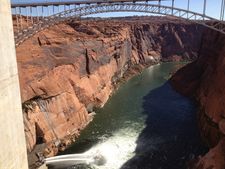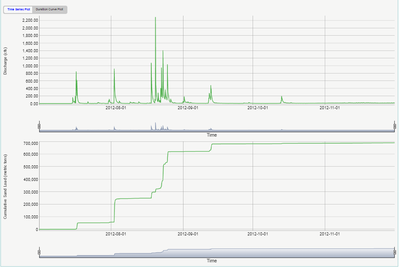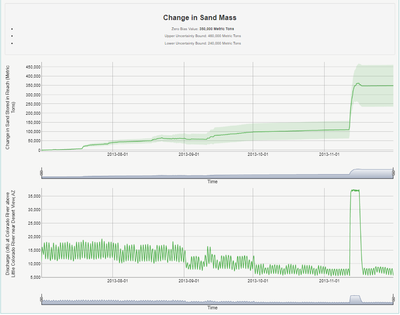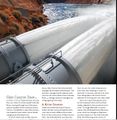Difference between revisions of "GCDAMP- HFE 2012"
From Glen Canyon Dam AMP
Cellsworth (Talk | contribs) |
Cellsworth (Talk | contribs) |
||
| Line 88: | Line 88: | ||
*'''No Substantial Change''' in '''12 sandbars''' --- 36% of sites. | *'''No Substantial Change''' in '''12 sandbars''' --- 36% of sites. | ||
*'''Substantial Loss''' of '''3 sandbars''' --- 9% of sites. | *'''Substantial Loss''' of '''3 sandbars''' --- 9% of sites. | ||
| + | *The effects of the 2012 HFE, which had lower downramp rate than other HFEs, on sandbar topography was evaluated by analysis of the slope of the sandbar surfaces. For each of the three sites surveyed following the 2012 HFE, we computed sandbar slope as the gradient over a 0.75 m by 0.75 m moving window over a grid with 0.25-m cell size using the “slope” tool in ArcGIS version 10.5.1. We categorized the results into areas with slope greater than 8 degrees and areas with slope less than 8 degrees. The threshold of 8 degrees was used, because that is the approximate threshold for areas considered flat enough to use for camping (Kearsley and others, 1994; Hadley and others, 2018). [https://www.usbr.gov/uc/progact/amp/amwg/2019-03-06-amwg-meeting/20190301-HFE_Extended_Abstracts-Combined_FINAL.pdf] | ||
*'''RESULTS: 6 Months Later (MAY 2013)''' | *'''RESULTS: 6 Months Later (MAY 2013)''' | ||
Revision as of 11:23, 8 July 2020
| High Flow Experiment- 2012 | |
 |
Contents
[hide]2012 High Flow Experiment Snapshot
- The 2012 HFE represents the 1st controlled high flow release conducted under the HFE Protocol.
- A preliminary analysis of these images indicates that sandbar size increased at 52% of sites, remained unchanged and 39% of sites, and decreased at 9% of sites.
- Before and after images from the November 2012 HFE from each of the 33 sandbar sites monitored with remotely deployed digital cameras are available here.
Sediment Conditions
Fall Accounting Period- Paria input (July 1 - Nov 18) = 690,000
- Accumulated in Upper Marble Canyon (Jul 1 - Nov 18, lower bound) = 542,000
- Evacuated from Lower Marble Canyon (Jul 1 - Nov 18, lower bound) = -33,000
- Available for fall HFE: 542,000 - 33,000 = 509,000
- Paria input (Nov 19 - 24): 1,000
- Evacuated from Upper Marble Canyon (Nov 19 - 24, lower bound) = -466,000
- Accumulated in Lower Marble Canyon (Nov 19 - 24, lower bound) = 5,000
- Left over in Marble Canyon after HFE (Nov 19 - 24): 509,000 +1,000 - 466,000 + 5,000 = 49,000
- Paria input (Dec 1 to Apr 1) = 50,000
- Evacuated from Upper Marble Canyon (Dec 1 to Apr 1, lower bound) = -29,000
- Evacuated from Lower Marble Canyon (Dec 1 to Apr 1, lower bound) = -6,000
- Available for spring HFE: -29,000 - 6,000 = -35,000
HFE Details
Schedule & Duration
- Nov. 18 begin upramp to powerplant capacity
- Nov. 19- 12:00 p.m. open bypass tubes
- Nov. 23 - 7:00 p.m. end of HFE
- Total duration: 5 days & 5 hours (96 hours at peak release)
Ramp Rates
- Ramp up: 4,000 cfs/hr from 9,000 - 27,300 cfs, then 3,750 cfs/hr to peak
- Ramp down: 1,000 cfs/hr from 31,300 - 27,300 cfs, then 1,500 cfs/hr from 27,300 cfs
HFE Release Details
- Maximum total release: 42,300 cfs
- Powerplant capacity: 27,300 cfs
- River outlet tubes: 15,000 cfs
- Hydropower generation units available: 8
- River outlet tubes: 4
Releases and Lake Elevation
- Releases will range from 7,000 - 9,000 cfs prior to and after the HFE
- Lake elevation is projected to decrease by approximately 2.5 feet during the 5-day period
- Estimated acre feet of water bypassed during HFE: 79,000 af
- November volume = xx kaf
Costs
- Actual costs to hydropower: $1.918 million* (includes costs of 2012 Fall Steady Flow Experiment)
SUPPORTING DOCUMENTS
- Financial Analysis of Experimental Releases Conducted at Glen Canyon Dam during Water Year 2013 by D.J. Graziano, L.A. Poch, T.D. Veselka, C.S. Palmer,* S. Loftin,* and B. Osiek*
- USBR 2012 HFE LINK
- AZ Game & Fish_Glen Canyon Dam High Flow Releases-2012 VIDEO CLIP
- 2012 HFE video
- 2012 HFE pictures
- Sandbar Monitoring for November 2012 Controlled Flood
COMPLIANCE
SAND TRANSPORT caused by 2012 HFE
- @ RM30 = 390,000 metric tons
- @ RM60 = 380,000 metric tons
- @ RM87 = 540,000 metric tons
- @ RM225 = 970,000 metric tons
- At Diamond Creek (RM225), 1,810,000 metric tons were transported by the Colorado River between July 1, 2012, and July 1, 2013. Thus, 54% of the total delivery of sand to Lake Mead reservoir during this 1-year period occurred during approximately 5 days of the November 2012 HFE. For comparison, 45% of the total delivery of sand to Lake Mead reservoir during calendar year 2008 occurred during the 2008 HFE; the 2004 HFE delivered 40% of the total sand delivered to Lake Mead in calendar year 2004.
- 500,000 tons of sediment is equivelant to filling a football field 230 feet deep (KSalazar)
RESULTS OF 2012 HFE
- 2012 Sandbar tour: deposition following the 2012 high flow on the Colorado River in Grand Canyon
- Substantial Gain to 18 Sandbars--- 55% of sites.
- No Substantial Change in 12 sandbars --- 36% of sites.
- Substantial Loss of 3 sandbars --- 9% of sites.
- The effects of the 2012 HFE, which had lower downramp rate than other HFEs, on sandbar topography was evaluated by analysis of the slope of the sandbar surfaces. For each of the three sites surveyed following the 2012 HFE, we computed sandbar slope as the gradient over a 0.75 m by 0.75 m moving window over a grid with 0.25-m cell size using the “slope” tool in ArcGIS version 10.5.1. We categorized the results into areas with slope greater than 8 degrees and areas with slope less than 8 degrees. The threshold of 8 degrees was used, because that is the approximate threshold for areas considered flat enough to use for camping (Kearsley and others, 1994; Hadley and others, 2018). [1]
- RESULTS: 6 Months Later (MAY 2013)
- Most sandbars constructed by the 2012 HFE eroded by May 2013.
- 8 sites were still somewhat larger, 14 sites remained the same, 7 were smaller.
Effects on Resources
- Cultural: No adverse effects to historic properties of the 2012 HFE were identified. (USBR Memo 2013)
- HBC & Native Fish: No measuable positive effect on HBC or other native fish. (Provisional- unpublished data)
- RBT Monitoring: RBT in Glen Canyon moved very little during the period around HFE.
- Foodbase: Initial results do not indicate a strong effect on food base-- but is expected to take longer to recover over the winter period (GCMRC unpublished data)
- Kanab Ambersnail: FWS found in its 2011 BO that this loss of snails/ habitat would not jeopardize the continued existence of the snail
- Whirling Disease: HFE's pose little risk of spreading whirling disease (GCMRC Assessment)
- AZ News Central Video- HFE, Sediment, Jack Schmidt, monitoring LINK
- Feds’ AZ Central News_ Grand Canyon flood a success
- Arizona Game and Fish Wildlife Views article titled "A Changing Grand Canyon: Can high flows help?" (Published October 2012) -Bill Stewart
Contributor: Category: Sediment, Recreation, Water delivery







